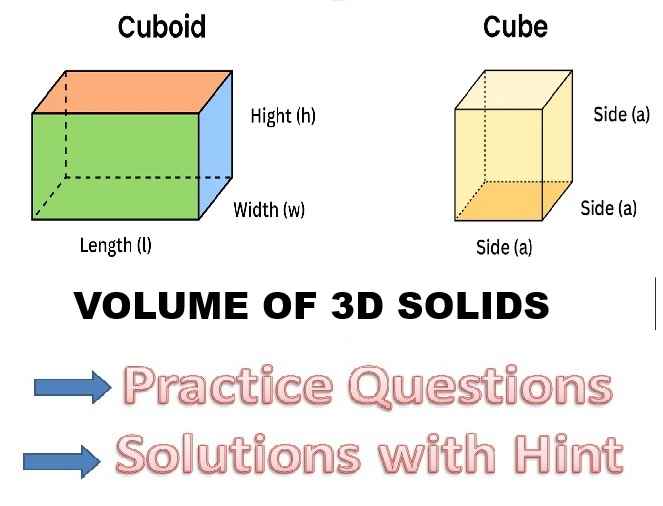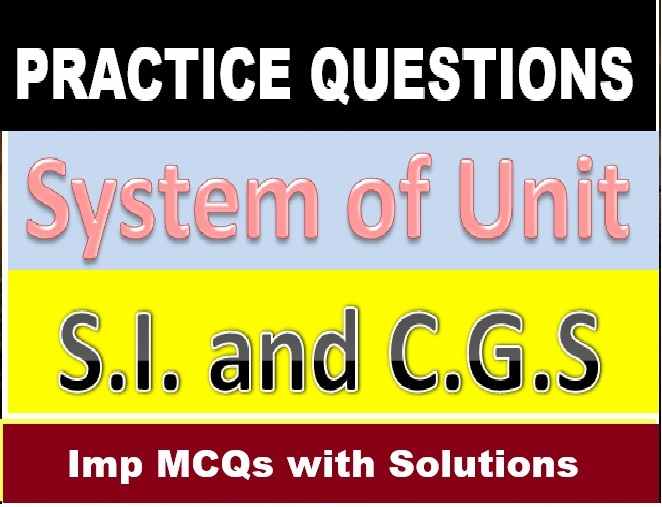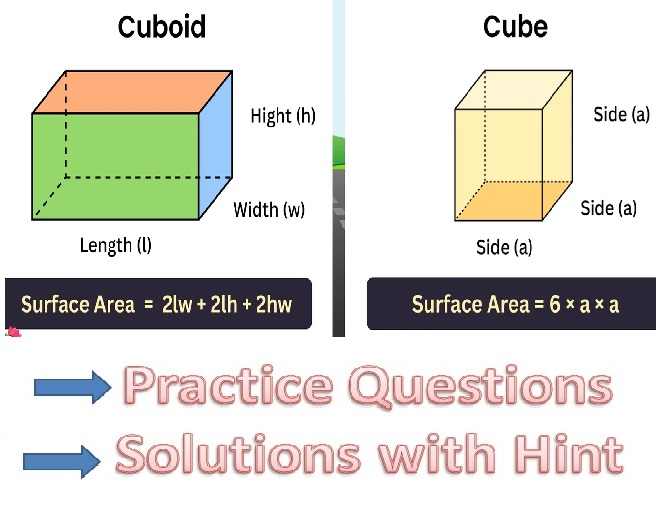ML Aggarwal Rational and Irrational Number Chapter Test Class 9 ICSE Maths Solutions. We Provide Step by Step Answer of Chapter Test Questions for Rational and Irrational Number as council prescribe guideline for upcoming board exam. Visit official Website CISCE for detail information about ICSE Board Class-9.
ML Aggarwal Rational and Irrational Number Chapter Test Class 9 ICSE Maths Solutions
| Board | ICSE |
| Subject | Maths |
| Class | 9th |
| Chapter-1 | Rational and Irrational |
| Topics | Solution of Ch-Test Questions |
| Edition | 2024-2025 |
Rational and Irrational Number Chapter Test
ML Aggarwal Class 9 ICSE Maths Solutions
Question 1. Without actual division, find whether the following rational numbers are terminating decimals or recurring decimals:
(i) 13/45
(ii) -5/56
(iii) 7/125
(iv) -23/80
(v) – 15/66
In case of terminating decimals, write their decimal expansions.
Answer:
(i) 13/45
We know that
The fraction whose denominator is the multiple of 2 or 5 or both is a terminating decimal
In 13/45
45 = 3 × 3 × 5
Hence, it is not a terminating decimal.
(ii) In -5/56
56 = 2 × 2 × 2 × 7
Hence, it is not a terminating decimal.
(iii) In 7/125
125 = 5 × 5 × 5
We know that
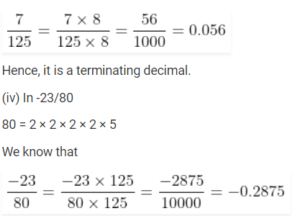
Hence, it is a terminating decimal.
(v) In – 15/66
66 = 2 × 3 × 11
Hence, it is not a terminating decimal.
Question 2. Express the following recurring decimals as vulgar fractions:

Now multiply both sides of equation (1) by 10
10x = 13.4545 ….. (2)
Again multiply both sides of equation (2) by 100
1000x = 1345.4545 …… (3)
By subtracting equation (2) from (3)
990x = 1332
By further calculation
x = 1332/990 = 74/55

Now multiply both sides of equation (1) by 1000
1000x = 2357.357357 ….. (2)
By subtracting equation (1) from (2)
999x = 2355
By further calculation
x = 2355/999
Question 3. Insert a rational number between 5/9 and 7/13, and arrange in ascending order.
Answer: A rational number between 5/9 and 7/13

Therefore, in ascending order – 7/13, 64/117, 5/9.
Question 4. Insert four rational numbers between 4/5 and 5/6.
Answer: Rational numbers between 4/5 and 5/6
Here LCM of 5, 6 = 30
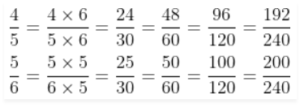
So the four rational numbers are
121/150, 122/150, 123/150, 124/150
By further simplification
121/150, 61/75, 41/50, 62/75
Question 5. Prove that the reciprocal of an irrational number is irrational.
Answer:
Consider x as an irrational number
Reciprocal of x is 1/x
If 1/x is a non-zero rational number
Then x × 1/x will also be an irrational number.
We know that the product of a non-zero rational number and irrational number is also irrational.
If x × 1/x = 1 is rational number
Our assumption is wrong
So 1/x is also an irrational number.
Therefore, the reciprocal of an irrational number is also an irrational number.
Question 6. Prove that the following numbers are irrational:

Answer:
(i) √8
If √8 is a rational number
Consider √8 = p/q where p and q are integers
q ˃ 0 and p and q have no common factor
By squaring on both sides
8 = p2/q2
So we get
p2 = 8q2
We know that
8p2 is divisible by 8
p2 is also divisible by 8
p is divisible by 8
Consider p = 8k where k is an integer
By squaring on both sides
p2 = (8k)2
p2 = 64k2
We know that
64k2 is divisible by 8
p2 is divisible by 8
p is divisible by 8
Here p and q both are divisible by 8
So our supposition is wrong
Therefore, √8 is an irrational number.
(ii) √14
If √14 is a rational number
Consider √14 = p/q where p and q are integers
q ≠ 0 and p and q have no common factor
By squaring on both sides
14 = p2/q2
So we get
p2 = 14q2 ….. (1)
We know that
p2 is also divisible by 2
p is divisible by 2
Consider p = 2m
Substitute the value of p in equation (1)
(2m)2 = 13q2
So we get
4m2 = 14q2
2m2 = 7q2
We know that
q2 is divisible by 2
q is divisible by 2
Here p and q have 2 as the common factor which is not possible
Therefore, √14 is an irrational number.
(iii) 
If  is a rational number
is a rational number
Consider = p/q where p and q are integers
= p/q where p and q are integers
q ˃ 0 and p and q have no common factor
By cubing on both sides
2 = p3/q3
So we get
p3 = 2q3 ….. (1)
We know that
2q3 is also divisible by 2
p3 is divisible by 2
p is divisible by 2
Consider p = 2k where k is an integer
By cubing both sides
p3 = (2k)3
p3 = 8k3
So we get
2q3 = 8k3
q3 = 4k3
We know that
4k3 is divisible by 2
q3 is divisible by 2
q is divisible by 2
Here p and q are divisible by 2
So our supposition is wrong
Therefore , is an irrational number.
, is an irrational number.
Question 7. Prove that √3 is a rational number. Hence show that 5 – √3 is an irrational number.
Answer:
If √3 is a rational number
Consider √3 = p/q where p and q are integers
q ˃ 0 and p and q have no common factor
By squaring both sides
3 = p2/q2
So we get
P2 = 3q2
We know that
3q2 is divisible by 3
p2 is divisible by 3
p is divisible by 3
Consider p = 3 where k is an integer
By squaring on both sides
P2 = 9k2
9k2 is divisible by 3
p2 is divisible by 3
3q2 is divisible by 3
q2 is divisible by 3
q is divisible by 3
Here p and q are divisible by 3
So our supposition is wrong
Therefore, √3 is an irrational number.
In 5 – √3
5 is a rational number
√3 is an irrational number (proved)
We know that
Difference of a rational number and irrational number is also an irrational number
So 5 – √3 is an irrational number.
Therefore, it is proved.
Question 8. Prove that the following numbers are irrational:
(i) 3 + √5
(ii) 15 – 2√7

Answer:
(i) If 3 + √5 is a rational number say x
Consider 3 + √5 = x
It can be written as
√5 = x – 3
Here x – 3 is a rational number
√5 is also a rational number.
Consider √5 = p/q where p and q are integers
q ˃ 0 and p and q have no common factor
By squaring both sides
5 = p2/q2
p2 = 5q2
We know that
5q2 is divisible by 5
p2 is divisible by 5
p is divisible 5
Consider p = 5k where k is an integer
By squaring on both sides
p2 = 25k2
So we get
5q2 = 25k2
q2 = 5k2
Here
5k2 is divisible by 5
q2 is divisible by 5
q is divisible by 5
Here p and q are divisible by 5
So our supposition is wrong
√5 is an irrational number
3 + √5 is also an irrational number.
Therefore, it is proved.
(ii) If 15 – 2√7 is a rational number say x
Consider 15 – 2√7 = x
It can be written as
2√7 = 15 – x
So we get
√7 = (15 – x)/ 2
Here
(15 – x)/ 2 is a rational number
√7 is a rational number
Consider √7 = p/q where p and q are integers
q ˃ 0 and p and q have no common factor
By squaring on both sides
7 = p2/q2
p2 = 7q2
Here
7q2 is divisible by 7
p2 is divisible by 7
p is divisible by 7
Consider p = 7k where k is an integer
By squaring on both sides
p2 = 49k2
It can be written as
7q2 = 49k2
q2 = 7k2
Here
7k2 is divisible by 7
q2 is divisible by 7
q is divisible by 7
Here p and q are divisible by 7
So our supposition is wrong
√7 is an irrational number
15 – 2√7 is also an irrational number.
Therefore, it is proved.

Here
¾ is a rational number and √5/4 is an irrational number
We know that
Sum of a rational and an irrational number is an irrational number.
Therefore, it is proved.
Question 9. Rationalise the denominator of the following:



Question 10. If p, q are rational numbers and p – √15q = 2√3 – √5/4√3 – 3√5, find the values of p and q.
Answer:

By comparing both sides
p = 3 and q = -2/3
Question 11. If x = 1/3 + 2√2, then find the value of x – 1/x.
Answer:
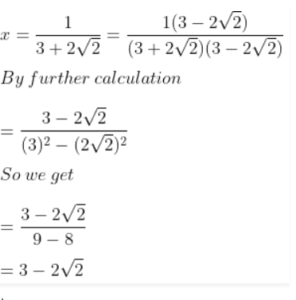
Here
1/x = 3 + 2√2/1 = √3 + 2√2
We know that
x – 1/x = (3 – 2√2) – (3 + 2√2)
By further calculation
= 3 – 2√2 – 3 – 2√2
So we get
= -4√2





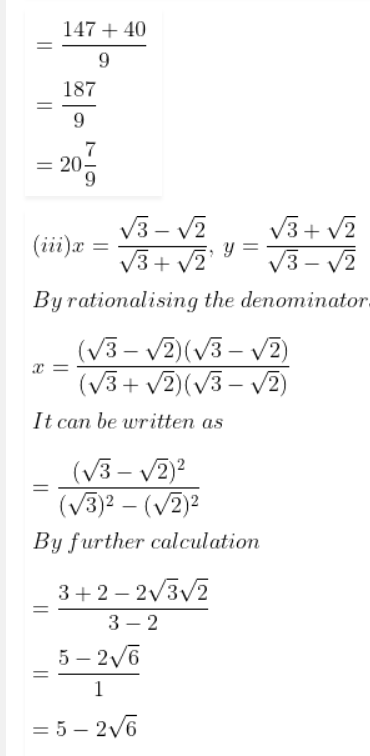


Answer:
We know that
√2 = √2
3.5 = √12.25
√10 = √10
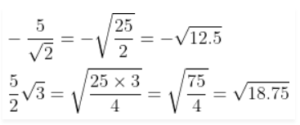
Writing the above numbers in descending order
√18.75, √12.25, √10, √2, – √12.5
So we get
5/2 √3, 3.5, √10, √2, -5/√2
Question 14. Find a rational number and an irrational number between √3 and √5.
Answer:
Let (√3)2 = 3 and (√5)2 = 5
(i) There exists a rational number 4 which is the perfect square of a rational number 2.
(ii) There can be much more rational numbers which are perfect squares.
(iii) We know that
One irrational number between √3 and √5 = ½ (√3 + √5) = (√3 + √5)/ 2
Question 15. Insert three irrational numbers between 2√3 and 2√5, and arrange in descending order.
Answer:
Take the square
(2√3)2 = 12 and (2√5)2 = 20
So the number 13, 15, 18 lie between 12 and 20 between (√12)2 and (√20)2
√13, √15, √18 lie between 2√3 and 2√5
Therefore, three irrational numbers between
2√3 and 2√5 are √13, √15, √18 or √13, √15 and 3√2.
Here
√20 ˃ √18 ˃ √15 ˃ √13 ˃ √12 or 2√5 ˃ 3√2 ˃ √15 ˃ √13 ˃ 2√3
Therefore, the descending order: 2√5, 3√2, √15, √13 and 2√3.
ML Aggarwal Rational and Irrational Number Chapter Test Class 9 ICSE Maths Solutions
Page 39
Question 16. Give an example each of two different irrational numbers, whose
(i) sum is an irrational number.
(ii) product is an irrational number.
Answer:
(i) Consider a = √2 and b = √3 as two irrational numbers
Here
a + b = √2 + √3 is also an irrational number.
(ii) Consider a = √2 and b = √3 as two irrational numbers
Here
ab = √2 √3 = √6 is also an irrational number.
Question 17. Give an example of two different irrational numbers, a and b, where a/b is a rational number.
Answer:
Consider a = 3√2 and b = 5√2 as two different irrational numbers
Here
a/b = 3√2/5√2 = 3/2 is a rational number.
Question 18. If 34.0356 is expressed in the form p/q, where p and q are coprime integers, then what can you say about the factorization of q?
Answer:
We know that
34.0356 = 340356/10000 (in p/q form)
= 85089/2500
Here
85089 and 2500 are coprime integers
So the factorization of q = 2500 = 22× 54

Is of the form (2m × 5n)
Where m and n are positive or non-negative integers.
Question 19. In each case, state whether the following numbers are rational or irrational. If they are rational and expressed in the form p/q, where p and q are coprime integers, then what can you say about the prime factors of q?
(i) 279.034
![]()
(iii) 3.010010001…
(iv) 39.546782
(v) 2.3476817681…
(vi) 59.120120012000…
Answer:
(i) 279.034 is a rational number because it has terminating decimals
279.034 = 279034/1000 (in p/q form)
= 139517/500 (Dividing by 2)
We know that
Factors of 500 = 2 × 2 × 5 × 5 × 5 = 22 × 53
Which is of the form 2m × 5n where m and n are positive integers.
It is a rational number as it has recurring or repeating decimals
Consider
x = 76.17893 17893 17893 …..
100000x = 7617893.178931789317893…..
By subtraction
99999x = 7617817
x = 7617817/99999 which is of p/q form
We know that
Prime factor of 99999 = 3 × 3 × 11111
q has factors other than 2 or 5 i.e. 32 × 11111

(iii) 3.010010001….
It is neither terminating decimal nor repeating
Therefore, it is an irrational number.
(iv) 39.546782
It is terminating decimal and is a rational number
39.546782 = 39546782/1000000 (in p/q form)
= 19773391/500000
We know that p and q are coprime
Prime factors of q = 25 × 56
Is of the form 2m × 5n where m and n are positive integers

(v) 2.3476817681…
Is neither terminating nor repeated decimal
Therefore, it is an irrational number.
(vi) 59.120120012000….
It is neither terminating decimal nor repeated
Therefore, it is an irrational number.
— : End of ML Aggarwal Rational and Irrational Number Chapter Test Class 9 ICSE Maths Solutions :–
Return to :- ML Aggarawal Maths Solutions for ICSE Class-9
Thanks
Please Share with Your Friends

